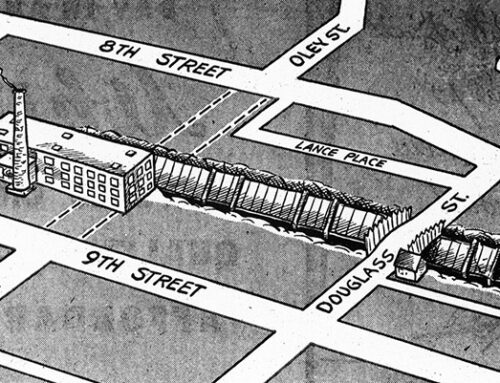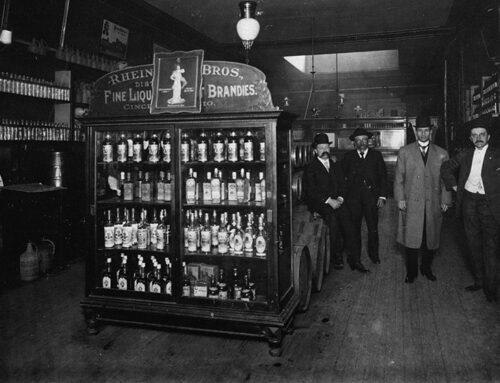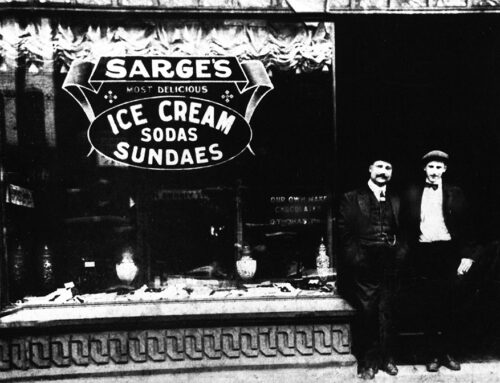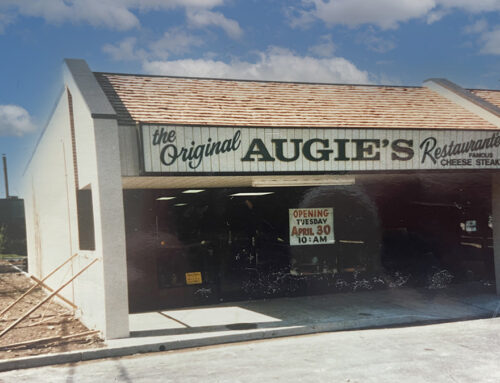B. & J. Saylor food store, formerly located at 401 Penn Street, once drew customers from near and far for its offerings of fancy fruits, baked goods, and specialty foods. Saylor’s blended its own high-grade coffees, which had many devotees. Another attraction was Saylor’s peanut butter, made while you watched.
Below: North side of 4th and Penn Streets, 1890, showing B. & J. Saylor and Reading Installment Co.

B. & J. Saylor, Inc. was founded in 1866 by Benjamin Saylor and his brother John. Benjamin Saylor was born in Heidelberg Township, Berks County, Pennsylvania, son of John and Catherine (Sheaffer) Saylor. He began his education in the public schools of Heidelberg Township. He was later sent for three years’ study to Union Academy at Womelsdorf, and supplemented the excellent education which he received by a great amount of independent reading. Indeed the habit formed at that time of his life continued with him until its close, and he was the possessor of a valuable library containing all the standard literary works besides many of the best modern books.
Upon leaving school he became himself a teacher at the schools of Robesonia, Berks County, and remained thus employed for about two and a half years. He then went to Philadelphia, where he entered the grocery store of his brother, John Saylor, and worked in a clerical capacity there for some ten years. The establishment of John Saylor was for a time located at the corner of Sixteenth and Market streets and later at the corner of Sixteenth and Cherry streets. During these years Benjamin Saylor gained much valuable business experience.
Below: Benjamin Saylor.

In the year 1862 he left his brother and volunteered for service in the United States army for three years. He entered the army in the month of August of that year with the commission of second lieutenant in Company C of the One Hundred and Nineteenth Regiment of Pennsylvania Volunteer Infantry, which was attached to the Sixth Army Corps. He possessed much military ability, and in a short time was promoted to the rank of first lieutenant in the same company, and one year later became captain of Company H of the same regiment. He continued as an officer of the line in active service for two years and his duties led him through some of the most notable campaigns of the war. He was in action at the storming of Marye’s Heights and at the battles of Chancellorsville, Mine Run, Rappahannock Heights, in which about one-third of the brigade under General David Russell was lost; at the great campaign under General Grant, which culminated in the battles of the Wilderness, Spottsylvania and Cold Harbor. He continued in action up to and through the first and second battles of Fredericksburg. His conduct in all these engagements was notable for its gallantry and was particularly distinguished at Cold Harbor, where he lost forty men of his company during the twelve days when they were continuously engaged in fighting day and night. It was at Cold Harbor that Captain Saylor received his commission as commissary of subsistence of the volunteer service of the United States army, in which capacity he served until the surrender of General Lee at Appomattox Court House, April 9, 1864, or practically the close of the war. It is interesting to note in this connection that, as related by Captain Saylor, he was, after the surrender of General Lee, ordered to turn over to the captured Confederate Army about one hundred and twenty head of cattle to feed the starving soldiers. All of Captain Saylor’s service was in the army under the command of General Sedgwick, which formed a part of the Sixth Army Corps, and he was finally honorably discharged on September 11, 1865, as brevet major.
After the close of the war, in the autumn of 1866, Mr. Saylor came to Reading, Pennsylvania, and here returned to his old business, but this time for himself. He opened a grocery store in partnership with his brother John, which was located at 14 & 16 North 4th Street. The first store was a comparatively small place, measuring eighteen feet on Fourth Street and twenty-eight feet in depth. The two brothers bought out the former owner, who was William Fisher, and remained in that location for about eleven years, carrying on a highly successful trade.
In the year 1877 they removed to 401 Penn street to the old mansion of Dr. Hiester H. Muhlenberg. Dr. Hiester Muhlenberg, a grandson of former Governor Joseph Hiester, erected the three-story mansion in the 1840s. Dr. Hiester Muhlenberg abandoned the practice of medicine early in his career and sold the property at 401 Penn Street to Fred Close who in turn sold it to Benjamin Saylor in 1877.
The establishment was equipped with coffee roasters, driven by steam and electric motors, and coffee mills and pulverizers. Here you could get freshly roasted coffee that Mr. Saylor blended himself. In May, 1888, John Saylor died and was succeeded by his son, Howard B. Saylor, who had been a clerk in the store from 1876. In 1904, Major Saylor was elected vice-president of the Colonial Trust Company, and in 1907 sold his interest in B. & J. Saylor, being succeeded by John Saylor, son of Benjamin Saylor, and nephew of John Saylor, the original partner.
The B. & J. Saylor store at 401 Penn Street was twice struck by fire: on July 20, 1933, and on November 21, 1935. Saylor’s old store, housed in what had been the Dr. Hiester H. Muhlenberg mansion, built in the 1840s, was razed in 1935 and rebuilt.
Below: Image Gallery – B. & J. Saylor Food Store – Touch or Click Images to Enlarge
After the failure of Reading Steam Heat Company around 1967, which serviced this property, Saylor’s closed the Penn Street store but continued in the wholesale business in a facility in southwest Reading.
Below: Vacant building at northeast corner of 4th and Penn Streets.

After years of standing vacant, the former Saylor store was razed in June 1980 to make way for the CNA insurance complex erected on the site. CNA would erect a large complex on the western half of the square, supplanting four existing buildings – the former Saylor Store at 401, a state liquor store at 403, a former Acme Market at 405, and a former A & P Market at 425.
Ground was broken July 1,1980, for CNA Plaza. Set against a gala Independence Day theme of red, white and blue, the day marked a monumental occasion for both CNA Insurance Companies and the city of Reading. Beginning construction of the quarter million-plus square foot office building ignited the spark for downtown Reading s restoration program. The building was to result in the largest combined industrial/governmental development project in Reading’s history. Officials from city and state government joined dignitaries from CNA and local business and industry to celebrate the historic event. CNA Chairman and Chief Executive Officer Edward J. Noha symbolically scooped the first dirt from high atop a front-end loader as several hundred souvenir hard-hatted guests applauded.
Below: CNA Ground-breaking.

On December 1980, construction began on the 260,000-square-foot building at 401 Penn Street. Residents of Reading, as well as eager CNA employees, watched CNA Plaza rise from the ground.


New Year’s Eve 1980 was far more than the end of one year and the launching of another. In Reading, at the construction site of CNA Plaza, a time capsule was filled with Reading and Berks County memorabilia and sealed to preserve the memories until 2030. Everything from a six-pack of Reading Beer to a listing of realty prices and mortgage rates went into the large stainless steel cylinder. Outlet store maps, a phone directory, a Reading Phillies baseball bat, a Pennsylvania Dutch dictionary, a solar brick, were just a few of many cherished memories collected and sealed.

Below: The CNA building was dedicated on June 1982.

For decades, CNA was a success story, with as many as 1,500 employees working there at its peak. But in recent years those numbers declined, and the company was only using a small portion of the building. In 2014 CNA moved its local operations to Spring Township and turned the building over to I-LEAD.
The decline and ultimate loss of CNA’s downtown presence dealt a serious blow to the surrounding area. In recent years the once thriving north side of the 400 block of Penn Street has been virtually devoid of commercial activity.
In December, 2019, Alvernia University announced that it was in the process of purchasing 401 Penn Street, with plans of turning it into the centerpiece of Alvernia’s new CollegeTowne initiative.
The CollegeTowne initiative will include the rebranding of Alvernia University’s O’Pake Institute to the O’Pake Institute for Economic Development and Entrepreneurship. The newly named institute will shift its mission to encompass playing host to a business incubator, providing programming on economic development and encouraging businesses to open shop in downtown Reading.
Once complete, the new downtown facility is expected to house more than 200 students and have the capacity to have twice that number taking classes there. It will be home for Alvernia’s business, communications and engineering programs, and will include a national franchise restaurant.
In February, 2020, after five months of collaborative talks, Alvernia University and I-LEAD, Inc. jointly signed a purchase and sale agreement for the building located at 401 Penn Street. The move puts Alvernia closer to making a reality of Reading CollegeTowne, the innovative strategy of expanding the campus into the downtown area to continue its Franciscan mission of education, service and community engagement.

















Leave A Comment